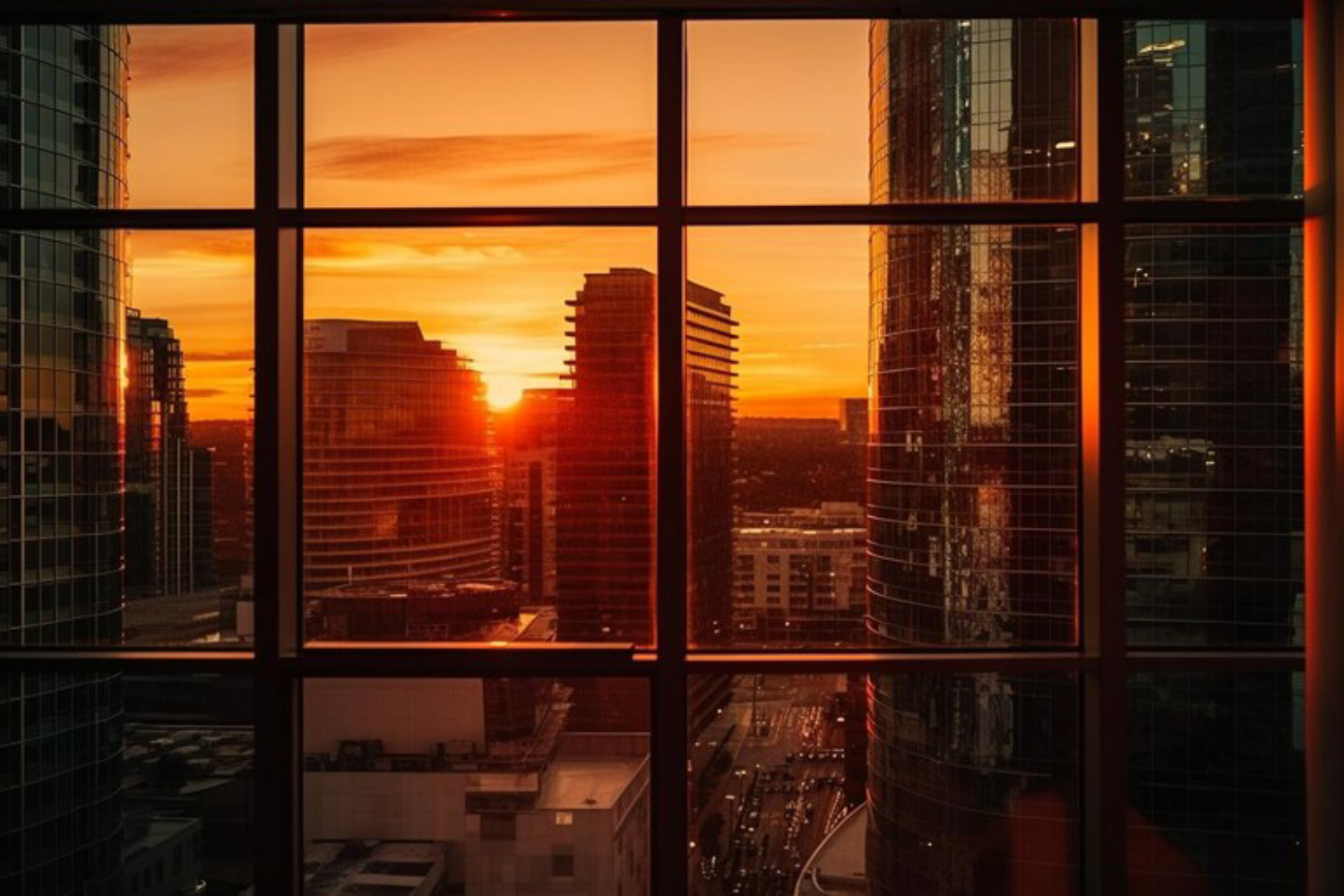Ceramic Window Tint: The Ultimate Heat Blocker
Ceramic window tint is revolutionizing the way we think about window films. With its advanced technology and superior heat-blocking properties, ceramic tint offers a level of performance and comfort that surpasses traditional window tint materials. Whether you’re looking to enhance the aesthetics of your car, improve the energy efficiency of your home, or create a more comfortable working environment in your office, ceramic window tint is the ultimate solution.
Unlike traditional window tint films that use dyes or metals to block heat, ceramic tint is made from ceramic particles that are non-metallic and non-conductive. This means that ceramic tint can block a significant amount of heat and UV rays without interfering with electronic devices’ signals, such as GPS, cell phones, or radios.
One of the most significant advantages of ceramic window tint is its ability to reject heat. It can block up to 99% of harmful UV rays and significantly reduce the amount of heat entering your vehicle or building. This not only creates a more comfortable environment but also helps reduce your reliance on air conditioning, leading to potential energy savings.
In this blog post, we will explore the technology behind ceramic window tint, its benefits, applications, and installation process. We will also discuss maintenance tips to ensure your ceramic tint remains in top condition for years to come. If you’re considering window tint for your car, home, or office, ceramic window tint could be the perfect choice for you.
Importance Of Heat Rejection In Window Tinting
Heat rejection is a crucial aspect of window tinting that offers numerous benefits in various applications, from automotive to residential and commercial buildings. The primary purpose of heat rejection in window tinting is to reduce the amount of heat that enters a vehicle or building through the windows, creating a more comfortable interior environment while also providing energy-saving benefits.
One of the key benefits of heat rejection is improved interior comfort. By reducing the amount of heat that enters a vehicle or building, window tinting helps maintain a more consistent and comfortable temperature inside, especially in hot climates or during the summer months. This can lead to a more enjoyable driving or living experience and reduce the need for excessive use of air conditioning, thereby saving energy and reducing utility costs.
Additionally, heat rejection can help protect the interior of a vehicle or building from sun damage. Prolonged exposure to heat and sunlight can cause upholstery, furniture, and other materials to fade or deteriorate over time. By reducing the amount of heat and UV radiation that enters through the windows, window tinting can help preserve the interior aesthetics and prolong the life of interior components.
From an energy efficiency standpoint, heat rejection in window tinting can help reduce the load on HVAC systems. By minimizing the amount of heat that enters a building, window tinting can help maintain a more stable interior temperature, reducing the need for heating or cooling and ultimately lowering energy consumption and utility costs.
Overall, the importance of heat rejection in window tinting cannot be overstated. It offers a wide range of benefits, including improved interior comfort, protection from sun damage, and energy efficiency, making it a valuable investment for vehicles and buildings alike.
How Ceramic Window Tint Works
Ceramic window tint is a technologically advanced solution for controlling the heat and light that enters through windows. Unlike traditional window tinting materials that use dyes or metals to achieve their effects, ceramic tint utilizes ceramic particles that are non-conductive and non-metallic. This unique composition allows ceramic tint to block out a significant amount of infrared (IR) radiation without interfering with electronic signals or radio waves.
The key to how ceramic window tint works lies in its ability to block heat while maintaining visibility and reducing glare. IR radiation is the primary source of heat from sunlight, and ceramic tint is engineered to reflect and absorb a large portion of this radiation. By doing so, ceramic tint can significantly reduce the amount of heat that enters a vehicle or building through its windows, helping to keep the interior cool and comfortable.
Additionally, ceramic window tint can also block a high percentage of ultraviolet (UV) radiation, which is not only harmful to the skin but can also cause fading and damage to interior furnishings and upholstery. By blocking UV rays, ceramic tint helps to protect both the occupants of a vehicle or building and its interior surfaces from the damaging effects of the sun.
Overall, the innovative technology behind ceramic window tint makes it an excellent choice for those looking to improve comfort, protect their belongings, and enhance the energy efficiency of their vehicle or building.
 Benefits Of Ceramic Window Tint
Benefits Of Ceramic Window Tint
- Superior Heat Rejection: Ceramic tint is highly effective at blocking infrared (IR) radiation, which is the primary source of heat from the sun. This helps to keep the interior of a vehicle or building cooler, reducing the need for air conditioning and improving overall comfort.
- UV Protection: Ceramic tint blocks a high percentage of ultraviolet (UV) radiation, which can cause skin damage and fade interior furnishings and upholstery. By blocking UV rays, ceramic tint helps to protect both occupants and interiors from the harmful effects of the sun.
- Glare Reduction: Ceramic tint reduces glare from sunlight, headlights, and other reflective surfaces, improving visibility and reducing eye strain for drivers and occupants.
- Clear Signal Transmission: Unlike metallic window tints, ceramic tints are non-conductive and non-metallic, allowing them to maintain clear signal transmission for electronic devices such as cell phones, GPS systems, and radios.
- Enhanced Privacy: Ceramic tint can also provide enhanced privacy by reducing the visibility of the interior of a vehicle or building from the outside.
- Durability: Ceramic window tint is known for its durability and longevity, often outlasting traditional window tint materials.
- Aesthetics: Ceramic tint has a sleek, modern appearance that can enhance the look of a vehicle or building.
- Quality of the Film: Higher quality ceramic films with better heat rejection properties and durability will generally cost more.
- Brand and Manufacturer: Well-known brands and manufacturers often command a premium price for their products.
- Installation: Professional installation is recommended for ceramic window tint to ensure proper application and performance. Installation costs can vary depending on the size of the windows and the complexity of the job.
- Coverage Area: The size of the area to be tinted, whether it’s a vehicle, home, or commercial building, will impact the overall cost.
- Warranty: Some ceramic window tint products come with warranties that can affect the price. Longer or more comprehensive warranties may come at a higher cost.
Installation Process
- Preparation: The windows must be thoroughly cleaned to remove any dirt, dust, or debris. This ensures that the tint adheres properly to the glass.
- Cutting the Tint: The ceramic tint film is carefully measured and cut to the size of the window. It is essential to leave a small margin around the edges to ensure proper coverage.
- Applying the Tint: A solution is sprayed onto the window to act as a lubricant. The tint film is then carefully applied to the inside of the window and positioned correctly.
- Removing Air Bubbles: A squeegee is used to remove any air bubbles trapped between the tint film and the glass. This step is crucial for a smooth and professional-looking finish.
- Trimming the Edges: Once the tint film is in place, the edges are trimmed to fit the exact size of the window. This step ensures a neat and clean appearance.
- Drying and Curing: The tint film needs time to dry and adhere to the glass properly. Curing time can vary depending on the weather conditions and the type of tint film used.
- Final Inspection: Once the tint film is dry, a final inspection is conducted to ensure that it has been installed correctly and that there are no imperfections.
It is essential to have ceramic window tint installed by a professional to ensure that it is done correctly and to avoid any issues such as bubbling or peeling. Professional installation also often comes with a warranty, providing peace of mind for the longevity of the tint.
Maintenance Tips
- Regular Cleaning: Clean the tinted windows regularly using a mild detergent or specialized window cleaner and a soft, non-abrasive cloth. Avoid using harsh chemicals or abrasive materials that can damage the tint.
- Avoid Scratching: Be gentle when cleaning the tinted windows to avoid scratching the surface. Use a soft cloth or sponge and avoid using sharp objects or abrasive materials.
- Avoid Harsh Chemicals: Avoid using ammonia-based cleaners or other harsh chemicals on the tinted windows, as they can damage the tint. Instead, use a mild detergent or specialized window cleaner that is safe for tinted windows.
- Use Soft Tools: When cleaning the windows, use soft tools such as a soft cloth or sponge to avoid scratching the tint. Avoid using abrasive materials such as brushes or scouring pads.
- Avoid Sharp Objects: Be careful when placing objects on or near the tinted windows to avoid scratching the tint. Avoid using sharp objects or tools near the windows.
- Regular Inspection: Regularly inspect the tinted windows for any signs of damage, such as peeling, bubbling, or discoloration. If you notice any damage, have it repaired or replaced by a professional.
- Professional Inspection: Periodically have the tinted windows inspected by a professional to ensure they are in good condition. A professional can identify any issues and recommend the necessary maintenance or repairs.
Ceramic window tint stands out as a remarkable solution for those seeking superior heat rejection, UV protection, and glare reduction without compromising visibility or electronic signal reception. Its advanced technology, utilizing non-metallic and non-conductive ceramic particles, sets it apart from traditional tinting materials.
Not only does ceramic tint effectively block infrared radiation and UV rays, but it also helps maintain a comfortable interior temperature, protects interior surfaces from fading, and enhances energy efficiency. Its durability and longevity make it a cost-effective investment in the long run.
However, to enjoy these benefits for years to come, proper maintenance is crucial. Regular cleaning with mild detergent or specialized cleaners, avoiding harsh chemicals and abrasive materials, and gentle handling during cleaning are key to preserving ceramic window tint.
In conclusion, ceramic window tint is a smart choice for enhancing comfort, protecting your belongings, and improving the energy efficiency of your vehicle or building. With its advanced technology and proven benefits, it’s worth considering for your next tinting project.
Ready to experience the ultimate heat blocker in window tinting? Contact us today to learn more about ceramic window tint and schedule a consultation. Protect your investment, enhance your comfort, and enjoy the benefits of ceramic window tint for years to come.




